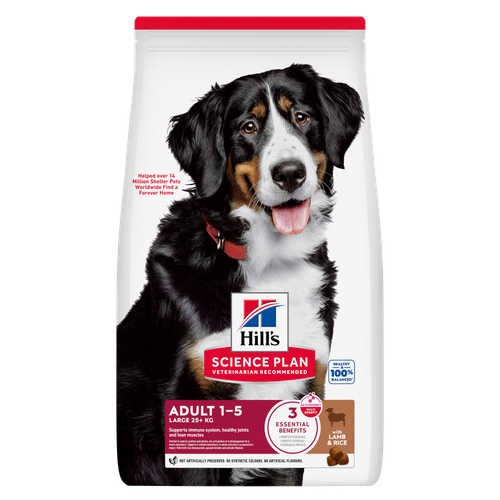
-
Find the right food for your petTake this quiz to see which food may be the best for your furry friend.Find the right food for your petTake this quiz to see which food may be the best for your furry friend.Featured products
 Adult Light Dog Food
Adult Light Dog FoodHill's Science Plan Light Adult Wet Dog Food is a complete premium pet food for adult dogs that tend to gain weight easily. This deliciously smooth loaf is formulated to deliver the appropriate amount of energy to support weight maintenance in adult dogs.
Shop Now Large Breed Adult Dog Food
Large Breed Adult Dog FoodHill's Science Plan Large Breed Adult Dog Food with Lamb & Rice is a complete pet food, specially formulated with ActivBiome+ Multi-Benefit Technology.
This food is specifically designed to fuel the energy needs of large breed dogs during the prime of their life.Shop Now Perfect Digestion Large Breed Puppy Food
Perfect Digestion Large Breed Puppy FoodPrecisely balanced nutrition with Hill's ActivBiome+ prebiotic blend actively contributes to supporting digestive health and overall wellbeing to help your pet feel their best
Shop NowFeatured products Sterilised Adult Cat Food
Sterilised Adult Cat FoodHill's Science Plan Adult Sterilised Cat Dry Food with Salmon is specially formulated with ActivBiome+ Multi-Benefit Technology. It is a precisely balanced nutrition, tailored to meet the needs of sterilised cats, to help keep sthem lean & healthy.
Shop Now CULINARY CREATIONS ADULT CAT FOOD
CULINARY CREATIONS ADULT CAT FOODHill's Science Plan CULINARY CREATIONS Adult cat food with Salmon & Carrots was formulated to provide a great-tasting experience to cats. Its delicious flavour and texture are combine with essential nutrients to support cats' optimal health during the prime time of their life. Specially formulated with high-quality salmon protein, essential taurine for heart health & balanced minerals to support kidneys & bladder.
Shop Now Adult Cat Food
Adult Cat FoodHill's Science Plan Adult Cat Food with Chicken is a complete pet food, specially formulated with ActivBiome+ Multi-Benefit Technology.
This food is specially formulated to fuel the energy needs of cats during the prime of their life.Shop Now -
Dog
- Dog Tips & Articles
-
Health Category
- Weight
- Food & Environmental Sensitivities
- Urinary
- Digestive
- Joint
- Kidney
-
Life Stage
- Puppy Nutrition
- Adult Nutrition
- Senior Nutrition
Cat- Cat Tips & Articles
-
Health Category
- Weight
- Skin & Food Sensitivities
- Urinary
- Digestive
- Kidney
-
Life Stage
- Kitten Nutrition
- Adult Nutrition
Featured articles The Incredible Science Behind Your Pet's Microbiome
The Incredible Science Behind Your Pet's MicrobiomeLearn what your pet's microbiome is, how it contributes to your pet's gut and overall health, and why nutrition is important in maintaining healthy microbiomes.
Read More Microchipping: The Facts | Hill's Pet
Microchipping: The Facts | Hill's PetThe government has announced that as of April 2016, all dogs in the UK must be microchipped by law.
Read More Pet Nutrition: What Makes "Healthy" Pet Food Healthy? | Hill's Pet
Pet Nutrition: What Makes "Healthy" Pet Food Healthy? | Hill's PetIn people, the right diet is very important. If you are eating the wrong way for your metabolism, activity level, age and lifestyle you could end up with health issues.
Read More -


If you have to leave your dog on their own it can bring on separation anxiety, this is usually caused by over-dependence on an owner. It can be the result of being weaned too early, being abandoned or simply due to the temperament of the dog.
You leave your dog alone for just twenty minutes while you run to do some shopping and when you return they’ve emptied the rubbish onto the kitchen floor, destroyed a pillow or had a pee in your hallway. If this sort of behaviour happens frequently your dog may be suffering from separation anxiety.
Over-dependence
Separation anxiety is common in dogs and is usually caused by over-dependence on an owner. It is a difficult but not impossible condition to treat. With patience you can overcome the destructive behaviour associated with separation anxiety completely.
What to look out for
The types of behaviour commonly associated with the problem are urinating and/or defecating in inappropriate places, destructive chewing and pawing, excessive barking or whining, a refusal to eat or drink, self-chewing or self-licking.
When you return home there is usually a prolonged, over-enthusiastic greeting too.
Punishment isn't the answer
Punishing your dog is the last thing you should do in this situation. They won't be able to associate the mess made while you were out with the punishment received a few hours later. Your dog may appear to act guilty but this is simply submissive behaviour - dogs don't feel guilt but they can anticipate a punishment.
Looking down, tucking their tail between their legs, slinking, showing their belly, these are all ways your dog shows submission, not guilt. Basically, they’re saying "Hey, I know you're the boss. Don't beat me up." Punishment only treats the symptoms of separation anxiety and not the root cause.
Come and go


Tasty Tips
The best way to deal with the problem is to decrease the dependence and anxiety your dog is feeling. This can be done simply by getting your dog used to people coming and going in the house.
When you leave, don't make a fuss or a big deal of saying goodbye as this will only increase anxiety. Similarly, when you return, give a calm greeting only after they have calmed down.
You could even try some 'practice' entrances and exits from the house to get your dog used to your movements. Do this several times a day and go through the whole routine as if you're actually going to leave.
Jingle your keys, pick up your bag or briefcase, put on your jacket and head out of the door. You could even hop in the car and drive around the block. After a minute or two, return.
As your dog gets used to these short outings, gradually increase their duration. Your goal is to be able to leave the house and return again without your dog working themselves into a frenzy or misbehaving when you're gone.
Once you can leave them alone for an hour or so you should be fairly confident about leaving your dog for an entire morning or afternoon.
Just ignore him!
If you continue to have trouble with your dog, you may need to tackle the dependency directly. This is tough, because it calls for ignoring your dog for a week or two.
Ask someone else to feed, walk and play with them, or better still, get a few people to do so. It won't be easy to ignore your dog, especially when they are desperately looking for your attention, but after a few weeks you'll find they are much less clingy.
As always, if you're having difficulty with your dog you should consult a vet who will be able to determine if your dog's misbehaviour is caused by separation anxiety or some underlying medical condition.
They may also be able to recommend a good behaviour specialist to help resolve the problem.


One of our staff authors prepared this article for you
Related products

Hill's Science Plan Large Breed Adult Dog Food with Lamb & Rice is a complete pet food, specially formulated with ActivBiome+ Multi-Benefit Technology.
This food is specifically designed to fuel the energy needs of large breed dogs during the prime of their life.

Hill's Science Plan Light Adult Wet Dog Food is a complete premium pet food for adult dogs that tend to gain weight easily. This deliciously smooth loaf is formulated to deliver the appropriate amount of energy to support weight maintenance in adult dogs.

Precisely balanced nutrition with Hill's ActivBiome+ prebiotic blend actively contributes to supporting digestive health and overall wellbeing to help your pet feel their best

Hill's Science Plan Adult Wet Dog Food with Turkey is a complete premium pet food for adult dogs from 1 year. This deliciously smooth minced turkey loaf is formulated to deliver the appropriate amount of energy to support the needs of adult dogs.
Related articles
Discover the causes, signs, and treatments of kidney disease in dogs and find methods of supporting your dog's kidney health. Learn more at Hill's Pet.

Dog obesity is a significant problem - learn more about helping your dog become trimmer and healthier through improved nutrition.

Learn to see the signs of an upset stomach in your dog, understand the triggers and explore some possible solutions.

Gurgling tummies in turmoil are not good news for pets. Owners who have to clean up the unfortunate consequences, digestive problems are one of the rare downsides to owning a pet.

Put your dog on a diet without them knowing
Our low calorie formula helps you control your dog's weight. It's packed with high-quality protein for building lean muscles, and made with purposeful ingredients for a flavourful, nutritious meal. Clinically proven antioxidants, Vitamin C+E, help promote a healthy immune system.
Put your dog on a diet without them knowing
Our low calorie formula helps you control your dog's weight. It's packed with high-quality protein for building lean muscles, and made with purposeful ingredients for a flavourful, nutritious meal. Clinically proven antioxidants, Vitamin C+E, help promote a healthy immune system.

